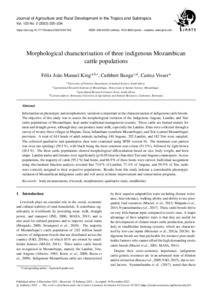| dcterms.abstract | Information on phenotypic and morphometric variation is important in the characterisation of indigenous cattle breeds. The objective of this study was to assess the morphological variation of the indigenous Angone, Landim, and Tete cattle populations of Mozambique, kept under traditional management systems. These cattle are farmed mainly for meat and draught power, although they can produce some milk, especially the Landim. Data were collected through a survey of twenty-three villages in Maputo, Gaza, Inhambane (southern Mozambique), and Tete (central Mozambique) provinces. A total of 614 heads of adult animals including 140 Angone, 292 Landim, and 182 Tete were sampled. The collected qualitative and quantitative data were examined using SPSS version 16. The dominant coat pattern was even (no spotting) (59.5 %), with black being the most common coat colour (51.5 %), followed by light brown (26.5 %). The three cattle populations showed morphological dierentiation based on size, body weight, and horn shape. Landim males and females were significantly (p<0.05) heavier than their Tete and Angone counterparts. Across populations, the majority of cattle (95.2 %) had horns, and 66.9 % of these horns were curved. Individual assignment using discriminant function analysis revealed that 73.0 % of Landim, 77.4 % of Angone, and 59.9 % of Tete cattle were correctly assigned to their respective populations. Results from this study indicate a considerable phenotypic variation of Mozambican indigenous cattle and will assist in future improvement and conservation programs. | eng |



